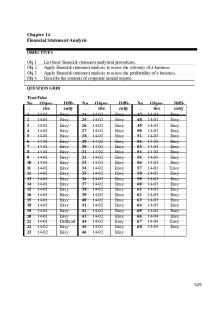Apple\'s Financial Analysis PDF

| Title | Apple\'s Financial Analysis |
|---|---|
| Author | Matheus Buarque |
| Course | Special Topics in Business Administration |
| Institution | University of Victoria |
| Pages | 3 |
| File Size | 193.7 KB |
| File Type | |
| Total Downloads | 32 |
| Total Views | 143 |
Summary
Financial Analysis of Apple's balance sheets, earning statements and more....
Description
Apple’s Financial Analysis Reference: Apple’s website, statements from September 29th, 2018, to September 26th, 2020, https://www.macrotrends.net/stocks/charts/AAP4355L/apple/income-statement Profitability Ratios: Evaluation; 2. Based on the data below we can see that Apple’s net profit has been decreased over the years. As Apple is one of the most profitable companies in the world, and even though net profit has decreased approximately 1% yearly since 2018, return on equity has been growing.
Net Profit Margin: September 30, 2019 21,24%
September 30, 2018 22,414%
September 30, 2020 20,914% Return on Equity: September 30, 2020 17,726%
September 30, 2019 16,323%
September 30, 2018 16,278%
Current Ratio: Evaluation; 3. Apple’s current ratio shows us a little decrease over 3 years in its ability to pay its obligations, although we can still notice that its ratio keeps above 1.0 which indicates Apple is reputable and reliable. However, it is important to wait for Apple’s 2021 statements to determine if it’s going to return its growth or not. September 30, 2020 1.25
September 30, 2019 1.36
September 30, 2018 1.41
Acid-Test Ratio: Evaluation; 3. As the current ratio, Apple’s acid-test ratio shows us a little decrease over 3 years, but it is still above 1.0 which is a good sign because it indicates that Apple can cover its short-term liabilities. it is important to wait for Apple’s 2021 statements to determine if it’s going to return its growth or not. September 30, 2020 1.23
September 30, 2019 1.34
September 30, 2018 1.39
Average age of Inventory: Evaluation; 4. As we can see from the ratios beneath Apple has great efficiency in selling its inventory quickly. It’s due to the fact Apple is one of the bestknown technology companies in the world. The average age of Apple’s inventory is 8/9 days. September 30, 2020 8.74
September 30, 2019 9.26
September 30, 2018 8.81
Net Assets to total Assets Ratio: Evaluation; 4. Since 2018 Apple has improved its net assets to total assets, showing a considerable decrease in its number of liabilities hold. September 30, 2020
September 30, 2019
September 30, 2018
0,20
0,26
0.29
Debt to Equity Ratio: Evaluation; 3. Here we have something to keep an eye on. Although Apple is a reliable company as already mentioned before, its D/E has been increasing considerably over the past 3 years. September 30, 2020 0,79
September 30, 2019 0,73
September 30, 2018 0.70
Sales, assets, and profit growth: Evaluation; 2. Apple’s sales growth has decreased approximately 10% over 3 years, based on its income statements provided, we can also identify that assets and profit also had decreased considerably compared to previous years. 2019 although weak in profit and sales, assets had a great growth compared to 2018, however, most recent statements show a negative asset margin. September 30, 2020
September 30, 2019
September 30, 2018
5% -$19,106 6%
-2,04% $31,480 -2%
15,86% $2,694 16%
Sales Assets Profit
Sep 30, 2020
Sep 30, 2019
Sep 30, 2018
2
15,86%
5%
16%
6%
-2,04%
-2%
-4,32
-7,43
Sources of financing: Evaluation; 4. We can see that Apple keeps its great, stable, and efficient retained earnings average over 2018, 2019, and 2020. Talking about its long-term debts we can see it had slightly grown between years 2019 and 2020.
Retained Earnings Long Term Debit
September 30, 2020
September 30, 2019
September 30, 2018
$57,411 $98,667
$55,256 $91,807
$59,531 $93,735
Share Holders
Sep 30, 2020
Sep 30, 2019
-
Sep 30, 2018
120
100
80
60 98,667
91,807
93,735
40 57,411
55,256
59,531
20
0 Retained Earnings
Long Term Debit...
Similar Free PDFs

APPLES APPLES APPLES
- 22 Pages

An Analysis of Scent of Apples
- 3 Pages

Scent of Apples
- 2 Pages

Financial Analysis Final Paper
- 22 Pages

Ch14 Financial Statement Analysis
- 52 Pages

001 Financial Statements Analysis
- 50 Pages

Financial statements analysis
- 74 Pages

financial statemnt analysis
- 19 Pages

UBER Technologies Financial Analysis
- 14 Pages

Financial Statement Analysis DIgi
- 13 Pages

Apple\'s Financial Analysis
- 3 Pages
Popular Institutions
- Tinajero National High School - Annex
- Politeknik Caltex Riau
- Yokohama City University
- SGT University
- University of Al-Qadisiyah
- Divine Word College of Vigan
- Techniek College Rotterdam
- Universidade de Santiago
- Universiti Teknologi MARA Cawangan Johor Kampus Pasir Gudang
- Poltekkes Kemenkes Yogyakarta
- Baguio City National High School
- Colegio san marcos
- preparatoria uno
- Centro de Bachillerato Tecnológico Industrial y de Servicios No. 107
- Dalian Maritime University
- Quang Trung Secondary School
- Colegio Tecnológico en Informática
- Corporación Regional de Educación Superior
- Grupo CEDVA
- Dar Al Uloom University
- Centro de Estudios Preuniversitarios de la Universidad Nacional de Ingeniería
- 上智大学
- Aakash International School, Nuna Majara
- San Felipe Neri Catholic School
- Kang Chiao International School - New Taipei City
- Misamis Occidental National High School
- Institución Educativa Escuela Normal Juan Ladrilleros
- Kolehiyo ng Pantukan
- Batanes State College
- Instituto Continental
- Sekolah Menengah Kejuruan Kesehatan Kaltara (Tarakan)
- Colegio de La Inmaculada Concepcion - Cebu




